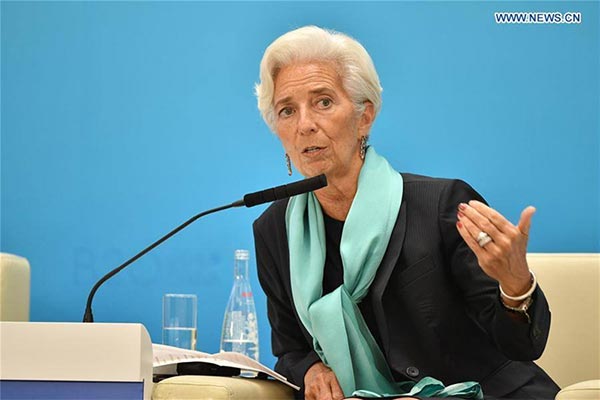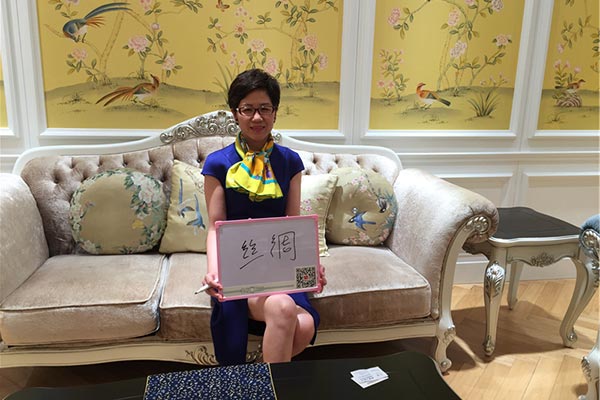 |
|
A Wensli silk scarf adds a distinctive color to the professional attire of Christine Lagarde, IMF president, at the B20 and G20 Hangzhou Summit. [Photo/Xinhua] |
During the G20 Hangzhou summit, IMF president Christine Lagarde chose a Chinese brand to add a distinctive touch to her attire.
Winning the favor of the financial fashion icon was a Hangzhou-based silk brand, Wensli. Lagarde wore it exclusively at her appearances in Hangzhou, while on most international occasions she wears only Hermès.
"She recognizes our design and appreciates our products," said Li Jianhua, CEO of Wensli Group, a major silk products provider for the B20 and G20 Hangzhou summit, in an interview with CCTV News. "She bought three scarves and said she would wear more Wensli scarves in the future."
Celebrity effect has proved a golden opportunity for the company. Many national and international leaders and dignitaries have worn its silk clothes on formal occasions, including the 2014 APEC meeting in Beijing.
But Li's wife, Tu Hongyan, chairwoman of the company, has a long-term vision. She is committed to building a time-honored brand in the global Chinese silk culture market.
The chairwoman, with black short hair and elegant makeup, wears a floral-patterned yellow and brown silk scarf to accent a fitted blue dress. She sits on a splendid sofa, leaning against Chinese-painting decorated silk-made cushions, with a rather European air. She speaks in a fast, determined, but soft tone, and sometimes wears a business-like smile.
"We have paved our way in China's sericulture industry over the past ten years, but we need to keep one thing in mind -- brand building. There is only one brand, 'made-in-China', and no sound Chinese local brands," said Tu. "But you see Chinese consumers are willing to pay a higher price in order to enjoy a wider selection of goods when overseas, so [we] manufacturers need to produce high-quality goods to meet their tastes."
Tu is used to being in the media spotlight; taking questions from journalists is part of her life. On the eve of the B20 and G20 summit, she has given a large number of interviews "to better promote the brand".
Her affection for silk products derives from the commercial environment in Hangzhou, a major silk production workshop in the Ming (1368-1644) and Qing (1644-1911) dynasties, and up until now, a major manufacturer in the global sericulture industry, equivalent to Lyon in France.
Tu Hongyan is descended on her mother's side from a silk production family in Hangzhou dating back to the Southern Song Dynasty (1127-1279).
Her mother, Shen Aiqin, set up the Jianqiao silk factory in 1975, and managed to turn it into a giant group with several billion dollars' worth of assets over the past four decades.
Shen sent her daughter to Japan where Tu spent one-year in a textile company after her college graduation in the early 1990s, a time when Japan was gaining a reputation for good-quality textiles and other products.
"I learned the spirit of craftsmanship there, and I've applied it to everything in life, to my products and my company," said Tu.
After returning, Tu did every single job in her mother's company until she took over the business four years ago to focus on one thing -- brand building.
The acquisition of Marc Rozier, going global
China is now globally the biggest producer and exporter of raw silk and silk yarn. It creates 70 percent of the world’s high-end raw silk, a major material in women's fashion.
Many Hangzhou-based silk factories and companies elsewhere in China have long done OEM (original equipment manufacturer) production for foreign brands, as has Wensli over the past 15 years for Prada, Gucci and Dior.
 |
|
Tu Hongyan, chairwoman of Wensli Group, suggests the word "silk" or 丝绸,as the best short descriptor for Zhejiang province, at Wensli headquarter, in Hangzhou. [Photo by Wang Zhen / China Daily] |
"You see, China exports high quality fabrics, not brands, partly because companies here haven't paid enough attention to R&D, and to building self-run brands," said Tu in an interview with China National Radio. "We've done the bulk of the work but earned the least of the money.”
Tu and her management team have set two ambitious goals -- to make the world love Chinese silk and to make Wensli a leading brand in China. They recently took a significant step forward.
In 2013, just one year after Tu took over the business from her mother, Wensli purchased Marc Rozier, an old established French silk firm located in Lyon, a historically renowned base for silk weaving. "We bought it to find out how the French make the world's best luxury goods," said Tu in an interview with China National Radio.
But that acquisition stumbled until the former owner of Marc Rozier, at the urging of Tu's French friends, finally agreed to pay a visit to Wensli headquarters in Hangzhou.
"Marc Rozier had a history of 126 years, but the late owner decided he didn't want to run the business anymore. So now we have injected new blood into it," said Tu. Wensli's supply-chain expertise and cash are helping the French company expand globally.
"I hope the acquisition is helping us improve quality and develop a global brand in turn," she added.
Making new interpretation of silk
Chinese silk fabrics were one of the major products traded along extensive transcontinental routes under one overarching umbrella, the Silk Road, beginning during the Han Dynasty (206 BC -220 AD).
Silk fabric, particularly in garments, was for years exclusively for royal families and noble classes in China due to the scarcity of materials and sophisticated silk waving techniques.
"You see the silk velvet garment, made of a type of woven tufted fabric," said Tong Yuge, an English interpreter in the Wensli Silk Cultural Museum. "That was for Emperor Qianlong to keep warm in winter time; feel how dense it is."
Despite that history and the fabric's aura of nobility and luxury, silk clothes and related products are now common.
"Actually, our understanding of silk has been changing," said Li Jianhua, speaking with CCTV news. "It comes up with lifestyle, more than fabric. We happen to have the opportunity to send the message to our consumers worldwide through world leaders and dignities during the G20 Hangzhou summit."
As a major silk souvenir supplier, Wensli spared no efforts to publicize its silk-made items, including wallpaper, artistic works, bed items, invitations, and of course, its classic -- scarves.
"All women love scarves, doesn't matter from the west or east," said Tu. Scarves were chosen as gifts for B20 guests and G20 summit guest's spouses. "You'll see lots of silk elements, as we've reinterpreted silk in many different ways for the G20 summit."
And, the company is developing more lifestyle products, like silk masks, mulberry tea, and wedding items, because the fabric itself is a natural product with no harmful chemicals. It does not deteriorate over time.
"We used to regard silk as a fabric, and material only, but now we see silk as a lifestyle, a combination of Chinese traditional culture with the pursuit of a healthy life," said Tong Yuge, a project manager in Wensli's financial department.
"As long as we constantly explore the value of silk, its healthy elements, its cultural aspects, we can go faster.
But, we need to be bold, and to make it real," said Tu.
Chinese elements, international design
From Tu's perspective, Chinese silk products need to provide something new while entering the global market, and the question is how to incorporate Chinese elements into international thinking.
"Look, I've got a scarf with a phoenix pattern, a typical Chinese element, right? But it doesn't look chic enough, so I invite French designers to do color matching, and the final product turns out to have both Chinese elements and international expression," said Tu.
Two years ago, Wensli design teams in China and France were asked to design a scarf with a theme of "the Silk Road". Many Chinese designers put highlights of the vicissitudes of that period of history, with wandering camels strolling on the yellow sand, whereas French designers focused on more than Chinese history. Their design showed a plump lady from the Tang Dynasty (618-907 AD) on one side of the scarf, with another elegant French lady on the reverse, connected by camels and exotic scenery: a cultural blending from the east to the west.
"So now, we are encouraging designers in China and France to work together on a series of high-end silk products to make products that are competitive in the global market," said Tu.
Two Marc Rozier design books are on display in Wensli's Silk Culture Museum. "You see these worn pages, on which they recorded every single pattern designed over the past 126 years," said Tong Yuge. "That's pretty impressive and respectable."
In comparison with century-old brands in Europe, Tu said her company needs to spend a longer time on brand building with the use of craftsmanship and innovation.
"We're still young, and we have a long way to go," said Tu.
"You know what, Boss Tu's mother, Shen Aiqing, passed away last month, a heavy blow to Boss Tu and her company, but Boss Tu has to cheer up," she added quietly.
After a group interview just two days ahead of the B20 summit, Tu said she had to dash for anther social activity that night.
"Boss Tu has got a tight schedule these days, as she is a participant of B20, you know, and Wensli is also a supplier for the summit," explained her assistant who handed another scarf to Tu before her departure.
My boss wears different Wensli-made scarves accordingly, trying her best to advertise our products on different occasions, she added.
Before taking the last question of the interview, Tu had paused a few seconds before saying,
"Doesn't matter how much money I've earned at the end of the day, what matters to me most is that Wensli will one day be respected by consumers.
I'd be more than happy to see that, as it would reward the efforts my mother and I have made."
